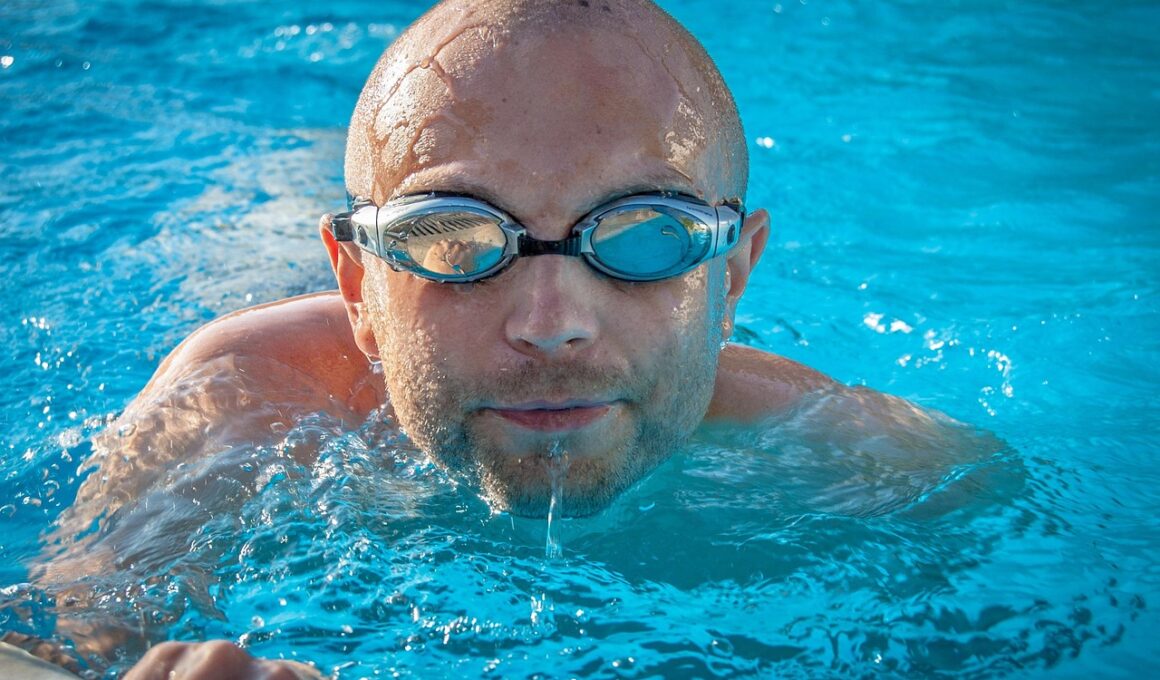The Role of Core Stability in Swimming Technique
Core stability is fundamental in enhancing swimming technique. A strong core allows swimmers to maintain body alignment, which is crucial in reducing drag and maximizing speed. Without core strength, swimmers often exhibit poor posture, leading to inefficient stroke mechanics. The abdominal, back, and pelvic muscles work harmoniously to support overall movement in the water. Proper core engagement stabilizes the body, contributing to smoother strokes and better breathing patterns. Additionally, core stability aids in transferring power efficiently from the arms and legs to the water. For instance, an unstable core can lead to rotational imbalances during strokes, which could hinder performance. Therefore, training core muscles should be a priority for swimmers. Incorporating exercises focused on core strength using dynamic movements can further enhance swimming. Examples include planks, bridging, and rotational exercises targeting the obliques. Not only does this enhance performance, but it also reduces the risk of injuries, allowing swimmers to train more effectively. With increased core strength, swimmers can optimize their techniques and execute strokes that are both powerful and fluid, thereby improving their overall swimming performance and enjoyment in the sport.
The importance of core stability in swimming extends to various strokes. Each stroke, whether it is freestyle, backstroke, breaststroke, or butterfly, requires distinct body positioning and balance. Core muscles play a pivotal role in providing the strength necessary to maintain these positions. Without adequate core strength, swimmers may struggle to execute strokes efficiently, resulting in fatigue and slower times. When swimmers prop up their core, they create a sturdy platform. This platform allows for effective propulsion and minimized resistance from the water. When analyzing elite swimmers, one can observe a clear emphasis on core control in their training regimes. Moreover, proper core engagement impacts their ability to streamline their bodies, an essential factor for efficient swimming. For instance, maintaining a straight line from head to toe considerably lessens drag. Swimmers notably experience more fluid movement when their core is engaged, needing less energy expenditure while swimming distances. Thus, exercises targeting body stability should involve dynamic movements that replicate swim strokes. Core stability training limits injury risk while significantly improving swimming performance. Swimmers who neglect this aspect of training may find it challenging to swim consistently at high levels.
Injury Prevention through Core Stability
Injuries in swimming can often be linked to a lack of core stability. Poor posture during swimming leads to stress on various joints and muscles, especially during turns and starts. Swimmers with weak cores are more susceptible to injuries such as shoulder impingement and lower back pain. These injuries can sideline a swimmer and disrupt their training regimen, ultimately affecting performance. To combat this issue, integrating core stability workouts into training is essential. This proactive approach emphasizes injury prevention while allowing swimmers to maximize their potential. Strong core muscles help to efficiently distribute forces throughout the body. Additionally, a stable core encourages proper body alignment. By enhancing alignments, swimmers can alleviate pressure points that contribute to injuries. Including functional exercises that mimic swimming motions in core workouts can yield significant benefits. Resistance training, pilates, and yoga are excellent choices for developing core strength. Focused training also improves overall physical resilience, enhancing endurance during intense swim sessions. Thus, prioritizing core conditioning is not only crucial for enhancing swim efficiency but also plays a critical role in injury prevention, fostering a long and successful swimming career.
Moreover, improving core stability does not merely support swimmers in the water—its benefits extend off the pool deck as well. Athletes who possess good core strength often exhibit enhanced overall athleticism. This added advantage translates into better performances in dryland training and skill-based activities. For instance, strong core muscles enhance agility and coordination—important aspects in any sport. This cross-training allows swimmers to partake in various activities, thus gaining functional strength that translates into better performance. Core strength exercises can also improve flexibility, which is crucial for swimming strokes. Increased flexibility leads to longer, more efficient strokes as swimmers can capitalize on their range of motion. Additionally, a focus on core stability can have psychological benefits, including increased confidence in one’s physical abilities. When swimmers know they can rely on their core strength, they become more willing to challenge themselves during training and competitions. Thus, a holistic approach that emphasizes core strength not only prepares swimmers for peak physical performance in the water but also contributes to their overall sporting abilities. Ultimately, a well-rounded approach to swimming training that includes a focus on core stability is invaluable for long-term success.
Core Stability Exercises for Swimmers
Focusing on specific exercises can significantly enhance core stability for swimmers. The plank is a fundamental exercise that engages multiple muscle groups, promoting core strength. Maintaining a straight line from the shoulders to the heels ensures proper form and maximizes effectiveness. Another effective exercise is the medicine ball rotational throw, which develops core strength and power by simulating swimming movements. Additionally, the bird-dog exercise enhances body awareness and balance while targeting the lower back and abs simultaneously. These exercises can be integrated into regular training routines to bolster core strength. Progressions can lead to dynamic versions of the basic exercises, increasing their challenge and efficacy. For instance, performing planks while alternating arm and leg lifts engages stabilizer muscles more efficiently. Another variant, the side plank, targets the obliques, critical for maintaining stroke efficiency. Resistance bands can also be incorporated into core training for added resistance. They provide essential feedback, particularly when performing rotational movements. To ensure continual progress, it’s vital to track improvements in the number and quality of repetitions. Consistent practice of these exercises develops enduring core stability, translating to noticeable performance gains in the pool.
The impact of core stability on swimming might be better understood through case studies of professional swimmers. Many elite athletes emphasize a strong core in their training programs. For example, renowned swimmers often include specific core conditioning sessions alongside their regular swim workouts. Coaches frequently observe significant improvements in the swimming efficiencies of athletes who prioritize core stability; athletes reported faster times, improved stroke mechanics, and enhanced endurance. Such observations lead to clubs and teams implementing core stability training as a fundamental aspect of their swim programs. Swimming workshops often feature guest speakers or coaches specializing in strength and conditioning. These professionals educate emerging swimmers on the importance of core strength, creating an awareness of its benefits. As a result, young athletes develop good habits early on, ensuring they recognize the need for core stability throughout their swimming careers. The synergy between core strength and swimming technique demonstrates a comprehensive approach to training. This multidimensional training model is critical for success in competitive swimming. Observational studies confirm that athletes committed to core stability are more likely to experience overall improvements, fostering a culture of excellence in the sport.
Conclusion: The Path to Enhanced Swimming
In conclusion, core stability proves essential in swimming, affecting various performance aspects and injury prevention. By highlighting its significance, swimmers can unlock their potential and embrace a more efficient stroke. Strong core muscles enable improved body alignment, leading to reduced drag and increased speed. Moreover, the training of core stability enhances overall athleticism, yielding benefits that extend beyond swimming. Incorporating targeted exercises into regular practice can effectively build this crucial strength. The successful cases of elite swimmers serve as evidence that prioritizing core stability is imperative for all levels of athletes. Lessons learned from these professionals encourage beginning swimmers to understand their body mechanics and the impact of core strength. Structuring training around enhancing core stability sets the foundation for swimmers pursuing excellence in the sport. Furthermore, adopting a well-rounded training strategy that emphasizes core conditioning ensures the longevity of an athlete’s career. As swimmers commit to developing their core strength, they enhance not only their technique but also their enjoyment of the sport. The relationship between core stability and swimming remains strong, creating a path toward enhanced performance and greater athletic fulfillment for swimmers everywhere.
Swimming combines technique, strength, and endurance, with core stability being a vital component. Engaging the core translates into a smooth and powerful swim stroke. It minimizes drag while enhancing propulsion in the water. Swimmers must commit to strength and stability training, ensuring core muscles are adequately developed. Injury prevention remains a high priority, as a strong core reduces the potential for common swimming-related injuries. Swimmers should recognize that core stability is not just an auxiliary concern but rather an integral part of training. Additionally, a well-rounded approach should include flexibility and balance training, creating a comprehensive program. Nutritional considerations play a role in recovery, allowing muscles to rebuild and grow stronger after workouts. Hydration cannot be overlooked, as it supports optimal performance during swimming sessions. Consistently monitoring progress is beneficial, as athletes can track improvements in both strength and swimming technique. This multifaceted strategy for enhancing core stability can lead to noticeable advancements. Swimmers who prioritize a well-structured training regimen that incorporates these elements are likely to excel in their pursuits, shaping the future of their swimming careers.


